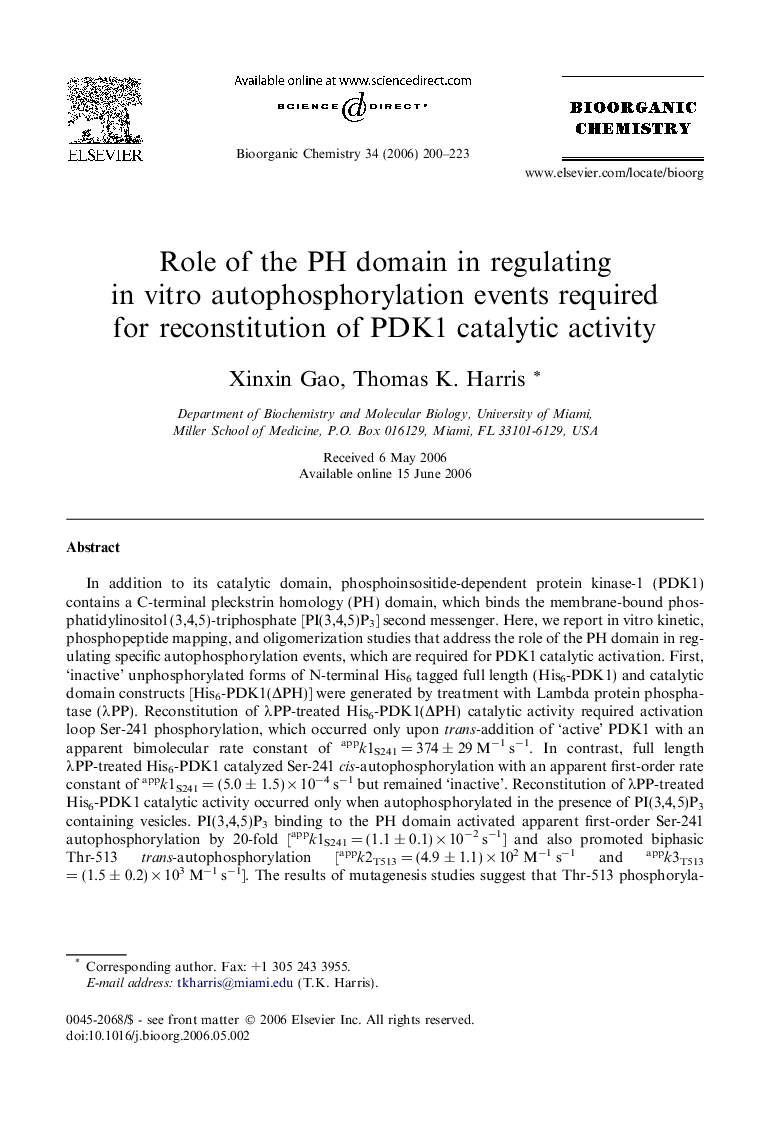| Article ID | Journal | Published Year | Pages | File Type |
|---|---|---|---|---|
| 1355408 | Bioorganic Chemistry | 2006 | 24 Pages |
In addition to its catalytic domain, phosphoinsositide-dependent protein kinase-1 (PDK1) contains a C-terminal pleckstrin homology (PH) domain, which binds the membrane-bound phosphatidylinositol (3,4,5)-triphosphate [PI(3,4,5)P3] second messenger. Here, we report in vitro kinetic, phosphopeptide mapping, and oligomerization studies that address the role of the PH domain in regulating specific autophosphorylation events, which are required for PDK1 catalytic activation. First, ‘inactive’ unphosphorylated forms of N-terminal His6 tagged full length (His6-PDK1) and catalytic domain constructs [His6-PDK1(ΔPH)] were generated by treatment with Lambda protein phosphatase (λPP). Reconstitution of λPP-treated His6-PDK1(ΔPH) catalytic activity required activation loop Ser-241 phosphorylation, which occurred only upon trans-addition of ‘active’ PDK1 with an apparent bimolecular rate constant of appk1S241 = 374 ± 29 M−1 s−1. In contrast, full length λPP-treated His6-PDK1 catalyzed Ser-241 cis-autophosphorylation with an apparent first-order rate constant of appk1S241 = (5.0 ± 1.5) × 10−4 s−1 but remained ‘inactive’. Reconstitution of λPP-treated His6-PDK1 catalytic activity occurred only when autophosphorylated in the presence of PI(3,4,5)P3 containing vesicles. PI(3,4,5)P3 binding to the PH domain activated apparent first-order Ser-241 autophosphorylation by 20-fold [appk1S241 = (1.1 ± 0.1) × 10−2 s−1] and also promoted biphasic Thr-513 trans-autophosphorylation [appk2T513 = (4.9 ± 1.1) × 102 M−1 s−1 andappk3T513 = (1.5 ± 0.2) × 103 M−1 s−1]. The results of mutagenesis studies suggest that Thr-513 phosphorylation may cause dissociation of autoinhibitory contacts formed between the contiguous regulatory PH and catalytic kinase domains.
Graphical abstractThe PH domain of PDK1 regulates a number of autophosphorylation events, which are required for protein trans-phosphorylation activity. The PH domain activates Ser-241 cis-autophosphorylation, which is required for catalytic activity. However, the PH domain autoinhibits activated PDK1(pS241) by blocking docking interactions with downstream protein substrates. This mode of autoinhibition is relieved upon binding of the PH domain to the PI(3,4,5)P3 second messenger, which facilitates trans-autophosphorylation of Thr-513 in the PH domain. Chemical modification of Thr-513 may cause dissociation of contacts formed between the PH domain and a protein substrate docking site on the catalytic kinase domain.Figure optionsDownload full-size imageDownload as PowerPoint slide
